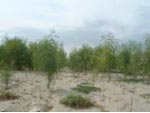


The New Forests Project distributes seeds of a wide range of fast growing, multipurpose agroforestry tree species, which are primarily used in the tropics. In the past few decades, agroforestry has emerged as a practice that can greatly increase farm productivity and the quality of life for poor smallholder farmers in the developing world.
Agroforestry is a way of farming that combines trees and shrubs with crops and/or livestock in order to attain a multitude of beneficial connections. Agroforestry recreates the natural environment and leads to more diverse, productive, profitable, healthy and sustainable land-use systems. The practice of agroforestry can provide poor smallholder farmers with the necessary food supply and extra income to improve their quality of life and the health of the surrounding environment. More recently, agroforestry has taken on added importance due to its capacity to increase carbon sequestration in degraded lands and increase the capacity of smallholder farmers to adapt to climate change.
Some of the services and products of the species provided by the New Forests Project include:
Agroforestry systems are more diverse and therefore more resilient to changes in climate. Multiple crops provide options when one or more fail due to changing weather patterns. Additionally, trees provide shade, increase water retention and reduce evaporation, helping regulate water flows and water availability; increasing the capacity of the farming systems to cope with changing precipitation patterns and increasing temperatures. Finally, trees also have the capacity to prevent erosion under increased rainy circumstances.
Agroforestry systems have the capacity to significantly increase carbon sequestration in marginal and degraded lands if appropriate management practices, that maximize carbon storage in the plants and ground, are put into practice. Because tree-based systems have higher capacity to store carbon than other agricultural practices, converting marginal areas where subsistence or low productivity agriculture is currently being practiced, into agroforestry systems, can greatly increase carbon storage while simultaneously increasing the livelihoods of farmers. This generates the potential to generate new sources of revenue through carbon credits.
To learn more about the tree species the New Forests Project distributes please click here